My first view of the ruins of Pompeii did not inspire awe or wonderment. Instead, and quite unexpectedly, I was perplexed. A few days earlier I had visited Herculaneum, the ancient Roman ruins that lay at the bottom of a 60-foot deep excavated pit. The same eruption of Mount Vesuvius that buried Herculaneum in A.D. 79 had also entombed Pompeii, yet here there was little in the way of excavation. At Pompeii I looked up to a town that roosted atop lush green hills.
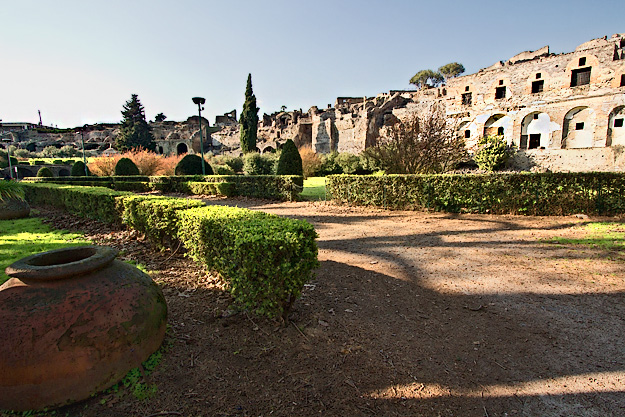
Shrugging off my confusion, I strode into what was once one of the most magnificent cities of the Roman Empire. Ruins of homes and shops lined both sides of the steep cobbled roadway. Here and there, artifacts testified to the luxurious lives led by Pompeiians. Once-burbling fountains in private courtyards stood silent and decaying. A large terracotta jar awaited flour from an adjacent millstone. Wells in the counter tops of tabernas, the fast food joints of ancient Rome, stood yawning and empty. All this and more stood in plain view, as most of the rooftops and many of the walls had succumbed to the crushing weight of ash that fell on the city.
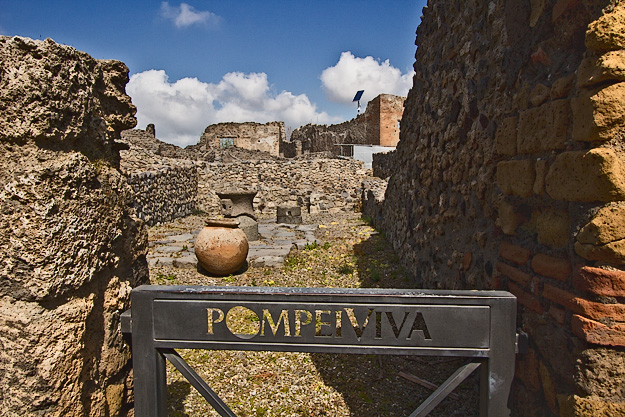
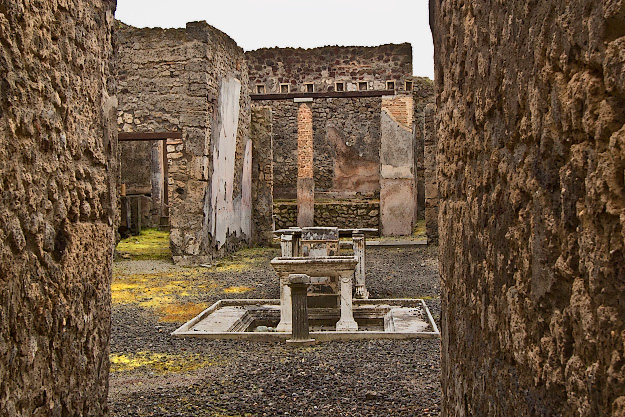
Unlike Herculaneum, which was buried by pyroclastic flows (destructive masses of very hot ash, lava fragments, and gases ejected explosively from a volcano that flow downslope at great speed), Pompeii was destroyed by volcanic ash. Vesuvius sent six successive clouds of ash high into the atmosphere. These dense clouds rumbled down the mountain until sheer weight caused their collapse. Like balloons being pricked by a pin, each cloud deflated and dumped its payload. The first three stopped just short of the city but the fourth breached its walls and the final two traveled nearly nine miles beyond the city. Laboratory experiments suggest that residents were exposed to temperatures in the range of 392 to 572 degrees Fahrenheit, high enough to cause instant death due to heat exposure. Extreme though they were, the temperatures were not high enough to vaporize soft body tissue. While only skeletal remains have been found in nearby Herculaneum and Oplontis, in Pompeii cooler ash covered the cadavers, allowing soft tissues to disintegrate slowly as the deposits cooled, leaving cavities in the ash. Centuries later, scientists poured plaster into these cavities, forming casts that allow us to see the bodies at the precise moment of death, right down to the expressions on their faces.
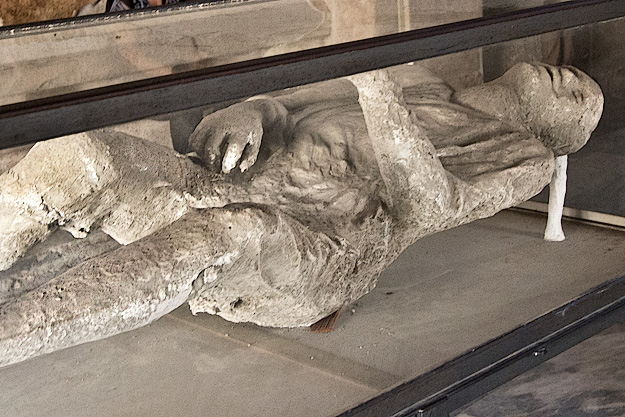
Though the victims of the eruption in Pompeii were well preserved, the same cannot be said of the city’s structures. I picked my way along the rough cobblestone streets, peering through shattered walls into homes that must have been exquisite in their day. After all these centuries, sophisticated frescoes sporting designs from nature and mythology are still visible on the walls, and complex mosaic patterns emblazon many of the floors.
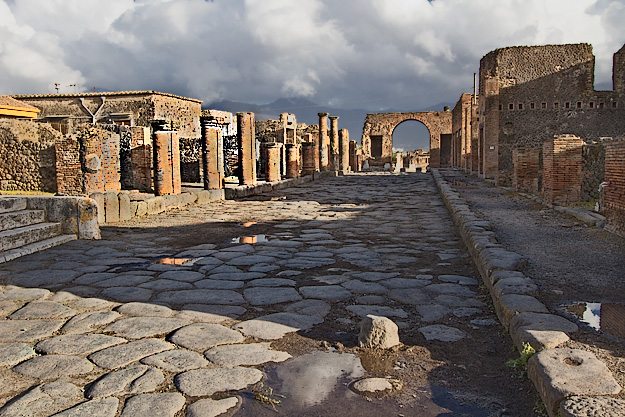

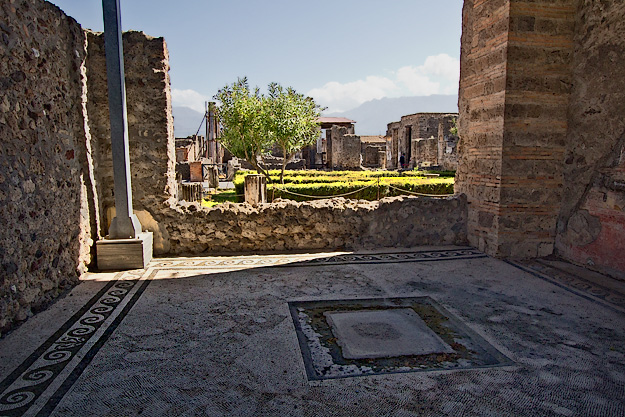
Sadly (but perhaps fortunately), many of the most impressive artworks are no longer on display at Pompeii. King Charles III of Spain, who ruled Naples and Sicily from 1734-1759, had them transported to the museum he founded in Naples, the National Museum of Archeology, where they still reside today. I was impressed by the art I saw at Pompeii but dazzled by the collection at the museum, which includes an exquisite gold serpent bracelet found at the House of Faun; columns that were faced from top to bottom in mosaics; and decorative mosaic wall hangings of sea creatures, historical battles, and even a skull.

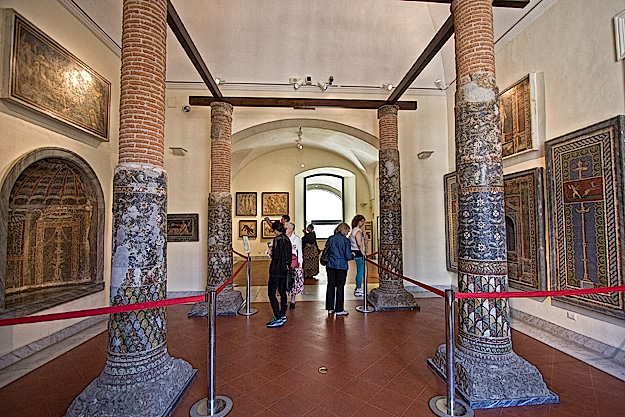
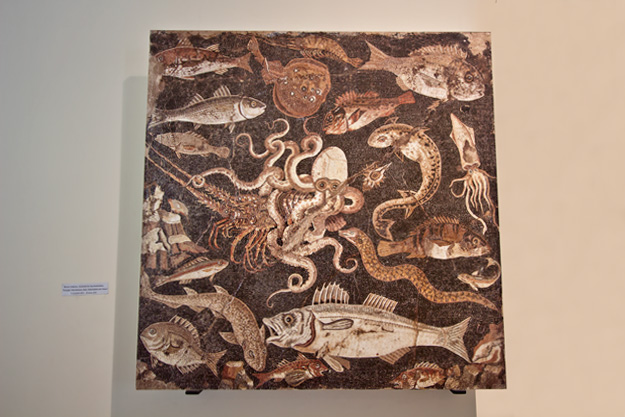
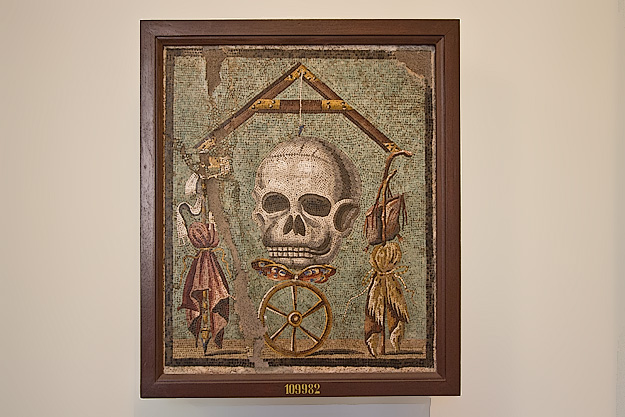
Though many of the private homes and small shops are worthy of a visit, it is the public buildings and spaces of Pompeii that truly astound. Originally located in the center of the fledgling city, the Forum was a large rectangular open space where open-air markets were held. Carts were prohibited from entering this area, perhaps to protect the opulent white travertine pavement from being damaged by the wheels that dug deep ruts into the cobblestone streets. The Forum was surrounded by many of the city’s most important buildings: the Basilica, seat of law and judgment; the Temple of Apollo; the Macellum, another major enclosed market; two honorary arches; and the Temple of Jupiter, among others.
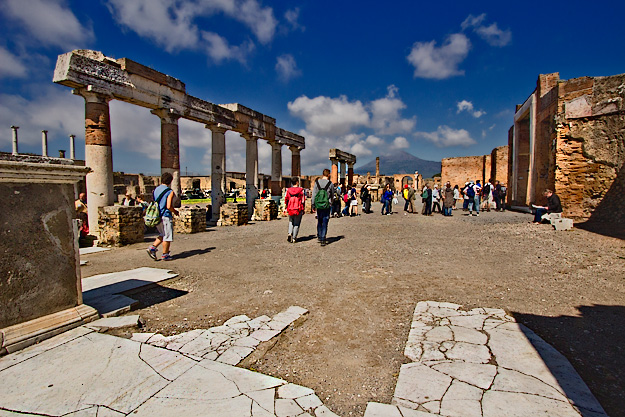
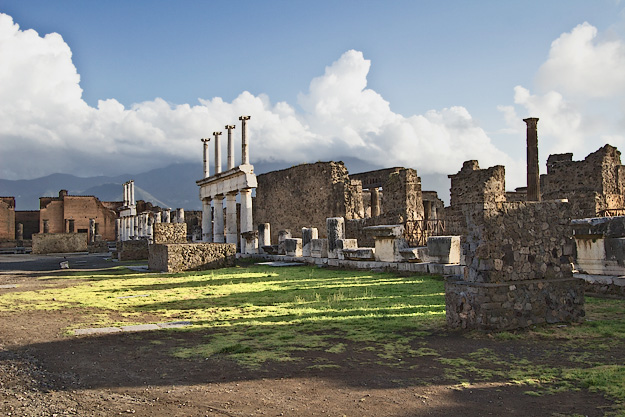


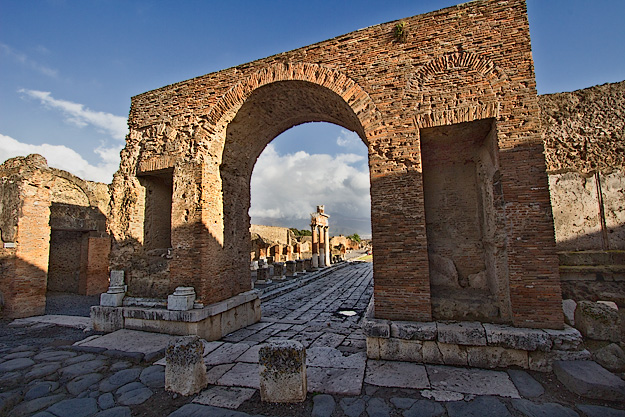
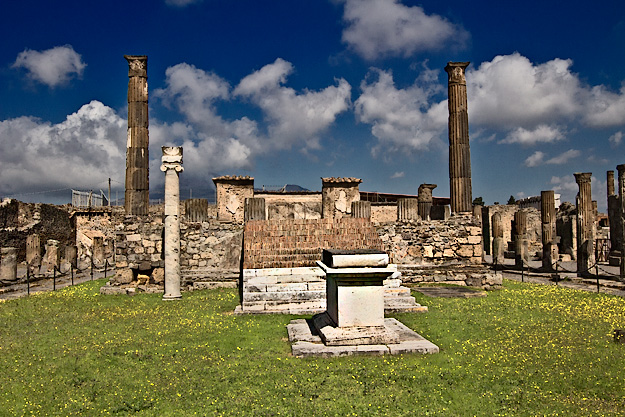
Other public facilities sprouted up as the city expanded. The public baths near the Forum were supplemented by two others, including the impressive Stabian Baths, which featured a large colonnaded open-air Palestra where clients exercised before retiring to the inner sanctums for a steam and a dip in the cold pool. A wealthy, enlightened populace demanded cultural amenities, thus a series of entertainment venues were constructed, including the small and great theaters, where tragedies and comedies were performed, and the enormous Amphitheater, where gladiators fought one another or wild beasts.
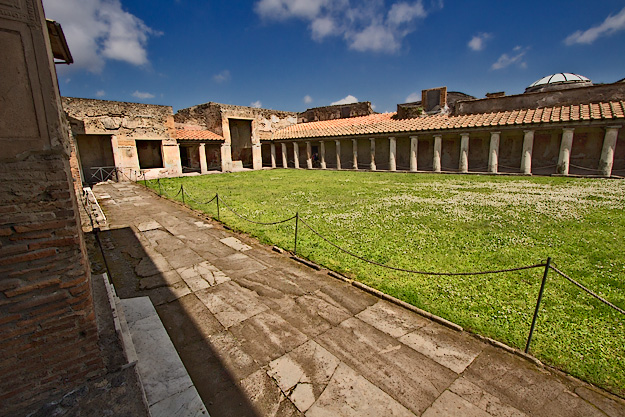
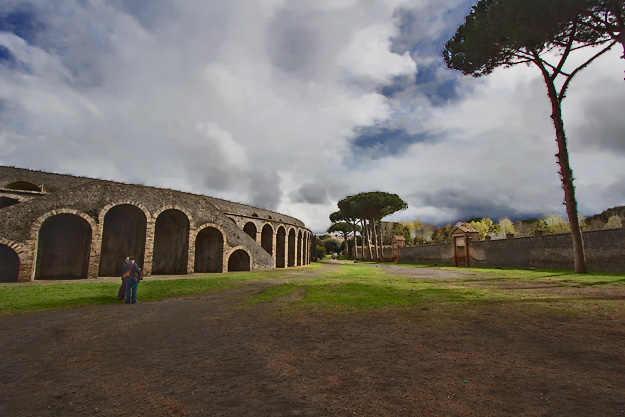
Pompeii is such a vast site that it was impossible to investigate thoroughly in one day, so I returned two days later to visit some of the lesser, but no less fascinating villas and shops. I was again pondering the lack of an excavation pit, when a private guide cleared up the mystery. As I eavesdropped, I learned that ash from Vesuvius had buried the entire hillside upon which Pompeii was built, leaving no vestige of the town. After discovery, the site was gradually excavated, revealing the city and returning the landscape to its pre-eruption elevation.
The guide pointed to a series of gently rolling hills beyond the ruins. “We don’t know for sure how large Pompeii was. As much as one-third of it may remain buried, but it’s certain that more ruins lie beneath each of those hills.” I turned my gaze toward those seemingly serene, grass-clad hills and shuddered at the realization that they may entomb hundreds more Pompeiians who perished on that terrifying day in A.D. 79. Perhaps we will never know. In the end, everything we think we know about Pompeii is an educated guess, backed up by scientific research. But even if we uncover every last inch of the ancient city, my guess is that Pompeii will never divulge all of its secrets.

How to Visit Pompeii Ruins:
Take the Circumvesuviana Train from Naples or Sorrento to Pompeii Scavi. Exit the station and turn right; the entrance to the ruins is just a short stroll up the street on the left-hand side. You can purchase a ticket for Pompeii for 11.00 Euro (~$15.00 USD), however if you plan to visit more than one site, purchase the global ticket that provides access over three days to all five ruins in the area (Pompeii, Herculaneum, Oplontis, Stabia, and Boscoreale) for 20 Euro ($27.25 USD). Tickets are available at any of the ruin sites, though be advised that lines at Pompeii may be long during high season.

I don’t have a bucket list, but I sure want to visit Pompeii some day. I didn’t realize it was so large though. Great article.
It’s huge, Nancy, and there is still 25-33% of the city yet to be excavated. It should definitely be on everyone’s bucket list.
I visited Pompeii about 12 years ago on a cruise excursion. Your beautiful descriptions have reminded me that it’s time to return for a more in-depth visit. Excellent photos!
Thanks so much Donna. I know that cruises offer a very limited window to visit Pompeii – I’ve been told that about 4 hours is about all you can manage. I spent two days there and still didn’t see everything. You just HAVE to go back 🙂
A good read! And timely (just watched the recent Pompeii movie on the airplane coming back from Bali). We didn’t know the ruins were so well-preserved – for some reason we thought there were only low-lying remnants, like at Carthage in Tunisia. When we can, we’d like to visit now…
A fascinating write up of your visit to Pompeii. If I ever make it to Italy, I’ll have to make sure we visit the site.
Thanks so much Anne-Marie. Hope you get to see it in person some day.
It’s been many, many years since I visited Pompeii. Reading your post reminds me of how intriguing I found it the first time and makes me want to return soon. My most vivid memories are of the mosaic floors and of a lovely little stray dog that followed us around the whole day…I named him Pompeii of course and so badly wanted to take him home with me. I suppose those memories make sense coming from a former interior designer and fanatic animal lover but it’s funny how little things stick with you.
Hi Sarah: I’ve always believed that it is the little things that stick with us and define our travels. Loved your story of the little dog 🙂
I loved Pompeii and all the details I was not aware of (or did not remember from school!). What an incredible witness to ancient history.
Hi Raul: Pompeii is certainly an amazing place. Glad you’ve had the opportunity to visit.
Beautiful photos, Barbara, as usual. Fantastic stories and history of Pompeii – thank you so much for increasing my knowledge and interest. I also appreciate your directions of how to get to some of these marvels.
Irene, On The Road
Thanks, as always, Irene. I really appreciate your loyalty as a reader.
Pompeii is really amazing, my trip there was too rushed. I need to go back and organise my time better.
Hi Zoe: I spent two days there and still didn’t see everything. And I suspect that will always be the case, as they continue to excavate.
Pompeii is one of those places I learned so much about growing up in school in history class and I’ve always wanted to visit. We are planning a trip to Italy in 2015 so we will be going here for sure! Thanks for the detailed explanations and the lovely photos!
You are very welcome Lauren. So glad you enjoyed my article and photos.